Space Weathering
Abstract
We are familiar with the slow, steady changes wrought on Earth's landscapes by the atmosphere and the water cycle, commonly called weathering. On airless bodies, the term “space weathering” has been generally been adopted to represent a suite of processes that serve to slowly alter regolith properties (as opposed to impacts and other processes with very rapid effects). These alterations can add or subtract physical or chemical components from surface minerals, and they can change the visible and near-infrared reflectance spectra of surfaces. Depending on the situation and the relative amount of exposure to space-weathering processes, it can potentially result in two very different compositions sharing similar spectral properties, or in the same composition having different spectral properties in different locations on the same surface. The apparently rapid timescale on which space weathering progresses combined with the existence of fresh, unweathered surfaces demonstrates that fresh material is brought to the surface of airless bodies. The mechanisms for doing so vary from object to object, with impact exhumation of fresh regolith and the creation of new regolith likely the most important process on the Moon and Mercury, while YORP-drive spin up and creation of new regolith via thermal fracturing (see Chapter 7) likely the most important processes on small asteroids.
Keywords
Asteroid; Space weathering; Solar wind; Processes; Regolith; Spectroscopy
What is Space Weathering?
We are familiar with the slow, steady changes wrought on Earth's landscapes by the atmosphere and the water cycle, commonly called weathering. On airless bodies, the term “space weathering” has been generally been adopted to represent a suite of processes that serve to slowly alter regolith properties (as opposed to impacts and other processes with very rapid effects) (see Hapke, 2001). These alterations can add or subtract physical or chemical components from surface minerals, and they can change the visible and near-infrared reflectance spectra of surfaces. Depending on the situation and the relative amount of exposure to space-weathering processes, it can potentially result in two very different compositions sharing similar spectral properties, or in the same composition having different spectral properties in different locations on the same surface.
At first blush, the implications of space weathering are disturbing. The interpretation of data from remote sensing is rooted in the idea that the data contain meaningful information. Visible and infrared spectroscopy is one of the most powerful and most widespread techniques for studying the airless bodies. If results from this technique were questionable, our confidence in our knowledge of the nature of these bodies would be shaken and we would be forced to design missions with scoops, impactors, and other methods of exposing fresh material in situ in order to surmount space weathering. Remote measurements could become suspect at best.
Happily, this is not the case. While space weathering is a factor that needs to be taken into consideration when interpreting airless body surfaces, it is not strong enough to erase or conceal the nature or composition of those surfaces. As described later, laboratory studies of returned samples from the Moon and asteroids along with spatially resolved spacecraft data and point-source astronomical data show us how to account for space weathering when interpreting data and how to use space weathering as a means of learning more about the surfaces we are interested in.
In this chapter, we discuss these processes of space weathering, the ways in which they obscure regolith properties, and also the ways in which they can potentially be used to determine regolith ages.
The Problem of Space Weathering
When we look at the Moon, we see a surface covered in craters. We also see pretty easily that some craters are distinctly brighter than others—Tycho crater, for example, dominates the southern part of the lunar nearside, with rays that stretch for hundreds of kilometers. The similar-sized Archimedes crater, on the other hand, lacks rays and is the same brightness as its surroundings. It was recognized prior to the Apollo landings that some process had to darken lunar materials with time and that brighter materials, like the rays of Tycho, were on average relatively recent exposures (Fig. 6.1).
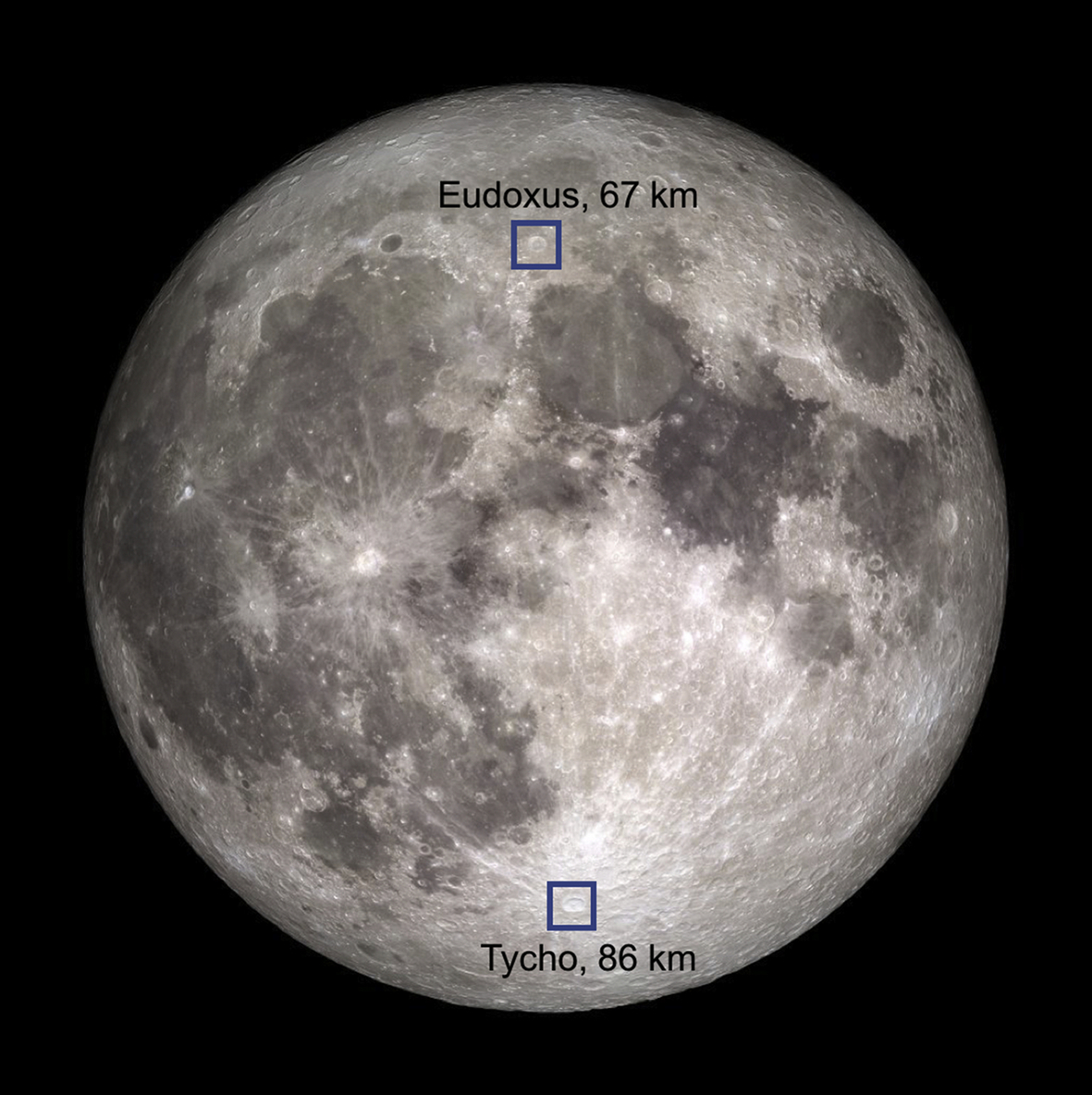
Study of the Apollo samples reinforced this conclusion—soils collected by the astronauts were good spectral matches to telescopic spectra of the landing areas, but both showed systematic differences from spectra of powders that were created in the laboratory from rocks that were collected intact. These studies also allowed an understanding of how soils “matured,” as discussed in the next section. From a remote-sensing point of view, lunar soils not only darken in the visible and near-IR spectral regions with time and exposure, but also obtain a steeper, reddened spectral slope (that is, increasing reflectance with increasing wavelength) and shallowed absorption bands as compared to fresher materials of the same composition. This is seen in Fig. 6.2, which shows the average spectra of the lunar highlands, lunar mare, and spectra of Apollo 17 samples. The rock and soil samples, despite being similar compositionally, show very different spectra. Looking further, the mare and highlands spectra are much more similar to the soil spectrum than the rock spectrum.
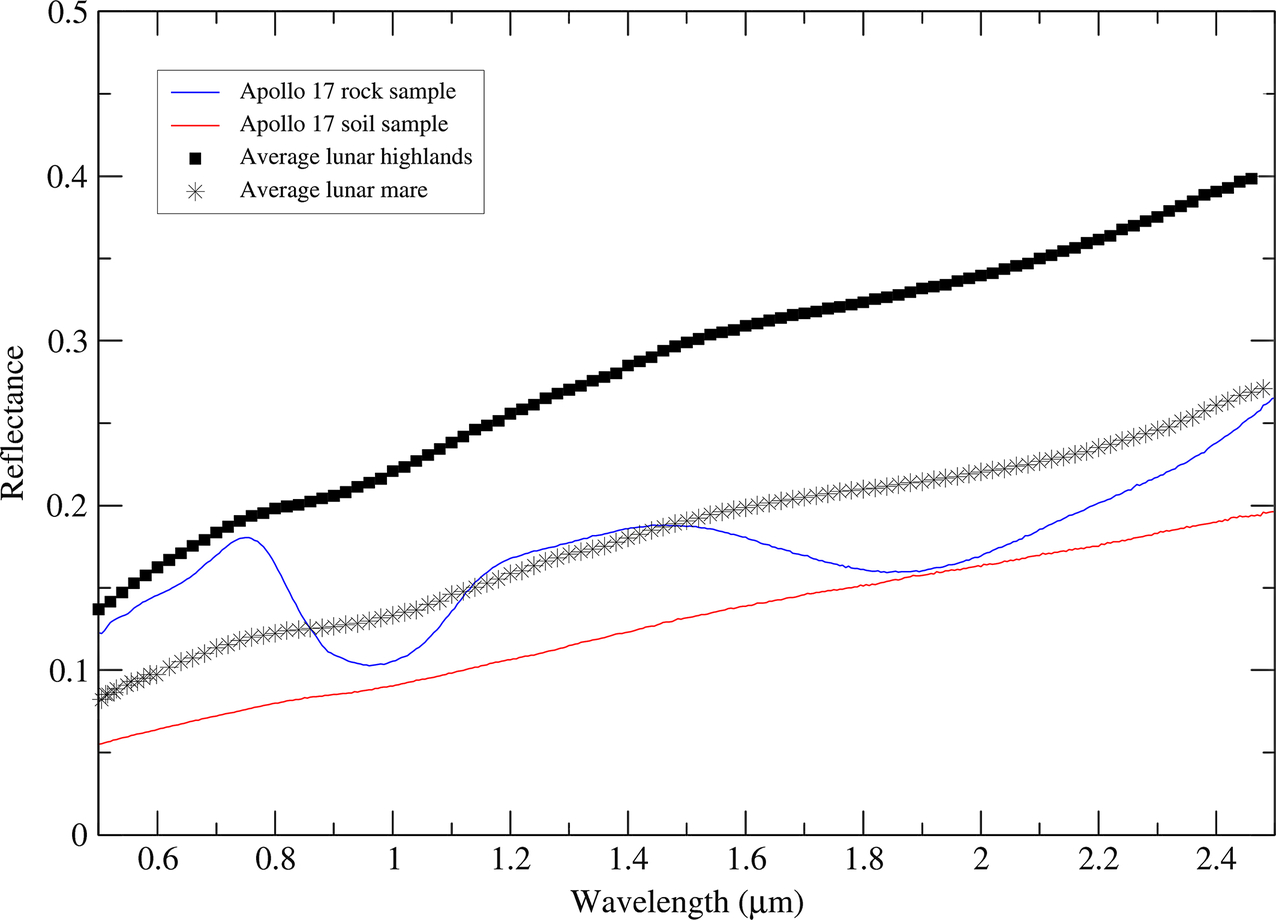
As spectra of asteroids began to accumulate in the 1970s and 1980s, a similar mismatch was noted between the spectra of the ordinary chondrites (OC) and the S-class asteroids. The OC meteorites dominate the meteorite collection, and their parent bodies should be extremely common among the near-Earth asteroids. On the other hand, the asteroids that most closely match the OC spectrally are classified in the uncommon “Q class,” while S-class spectra are the most common spectral type seen in the NEAs and should be abundantly represented in the meteorite collection. The differences seen between S asteroid spectra and OC spectra mirror the differences seen between mature and fresh lunar regolith: the S asteroids have lower albedos, steeper spectral slopes, and shallower absorption bands.
The nature of the relationship between the OC and S asteroids, often termed the “S asteroid problem,” was the subject of intense and ongoing research until the turn of the century, with details still being studied today. Three main factors made the S asteroid problem more difficult to address than studies of Apollo data to understand lunar space weathering: the specific parent bodies of the OCs were unknown, the samples spent time on Earth before collection, and loose soil does not come to Earth as meteorites (save in unusual lithified regolith breccias).
Two main theories arose to explain the spectral mismatch between OC and S asteroids: (1) The same processes occurring on the lunar soils were occurring on the asteroidal surfaces, and (2) The S asteroids and OC meteorites are not related, with spectral differences reflecting true differences in composition. The community consensus only moved toward favoring the existence of asteroidal space weathering after spacecraft visits to Ida and Eros, and it was not until samples from Itokawa were returned by the Hayabusa spacecraft that an undisputed connection between S asteroids and OC meteorites was demonstrated. Even so, apparent inconsistencies remain in the strength and specific effects of space weathering between Eros, Ida, and Itokawa, which remain a subject of research today: more mature material on Ida shows a redder spectrum than fresher material, while maturity differences on Eros are largely displayed as albedo differences rather than color differences. Even after the Hayabusa sample return, the science case for returning a more massive sample (or several massive samples) from an S asteroid surface remains strong.
Ironically, the close match between the spectra of Vesta and the HED meteorites has been used as an argument against those meteorites originating on that asteroid. Because the mismatch between S asteroids and OCs can be shown as due to space weathering, and because that mismatch is also seen in the lunar case, we might expect to see a mismatch between the HEDs and Vesta, where Vesta “should” have a steeper spectral slope and shallowed band depths compared to the meteorites. Because such a mismatch is not seen, the argument went, the apparent match is only coincidental and there is no connection between them.
This argument was not generally adopted, with counterarguments focusing on the relative lack of iron in the HEDs/Vesta compared to the OC meteorites leading to limited space weathering (see later) or postulating a magnetic field at Vesta that protected the surface from the solar wind. The arrival of Dawn at Vesta and its measurements of elemental abundances via its gamma-ray spectrometer confirmed the match between Vesta and the HEDs, though the lack of a magnetometer in the Dawn payload leaves the possibility of a vestan magnetic field untested but unfavored by theorists.
The Processes of Space Weathering
Airless body surfaces are exposed to several processes implicated in space weathering. Ultraviolet light and solar wind ions both directly interact with regolith, and micrometeorites carry their full kinetic energy in impacts rather than dissipating some of it in an atmosphere. All of these agents deposit energy on different spatial scales and can reach different depths in regolith, and they are expected or seen to vary in their relative strength across the inner solar system (Fig. 6.3).
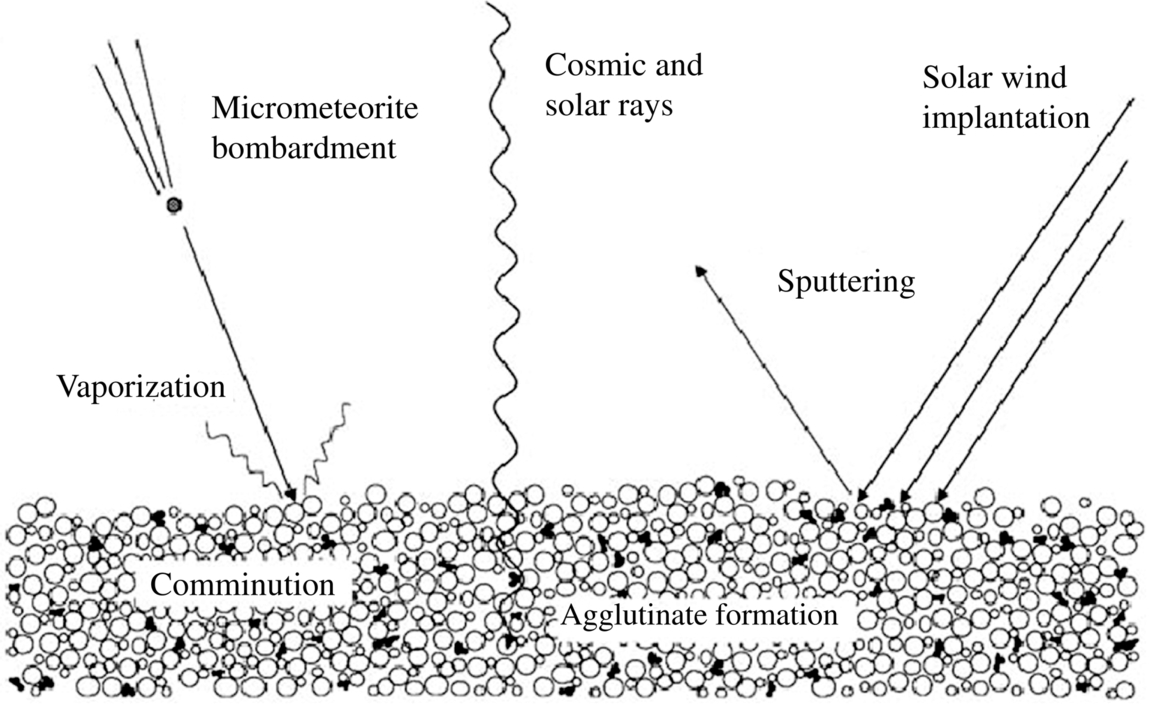
The strength of ultraviolet light and solar wind both decreases with the inverse square of solar distance, so objects in the asteroid belt at 3 AU will experience these effects at 1/9th the strength that the Moon or NEAs will experience. The abundance and speed of micrometeorites will also differ at 3 AU compared to 1 AU.
The space-weathering processes seen on the Moon appear to be intimately connected to metallic iron. TEM images of weathered lunar soil particles show sub-μm concentrations (“blebs”) of iron at or near the particle rims. It is thought that this metallic iron is generated by chemical reduction of oxidized iron found in silicates. This reduction occurs during micrometeorite impacts or through solar wind or cosmic ray bombardment. It is thought that solar wind hydrogen (discussed below) may aid the process. It is also thought that changes to mineral crystal structures like amorphization also take place during solar wind/cosmic ray bombardment, which can also cause spectral changes independent of the creation of sub-μm-scale iron (Fig. 6.4).
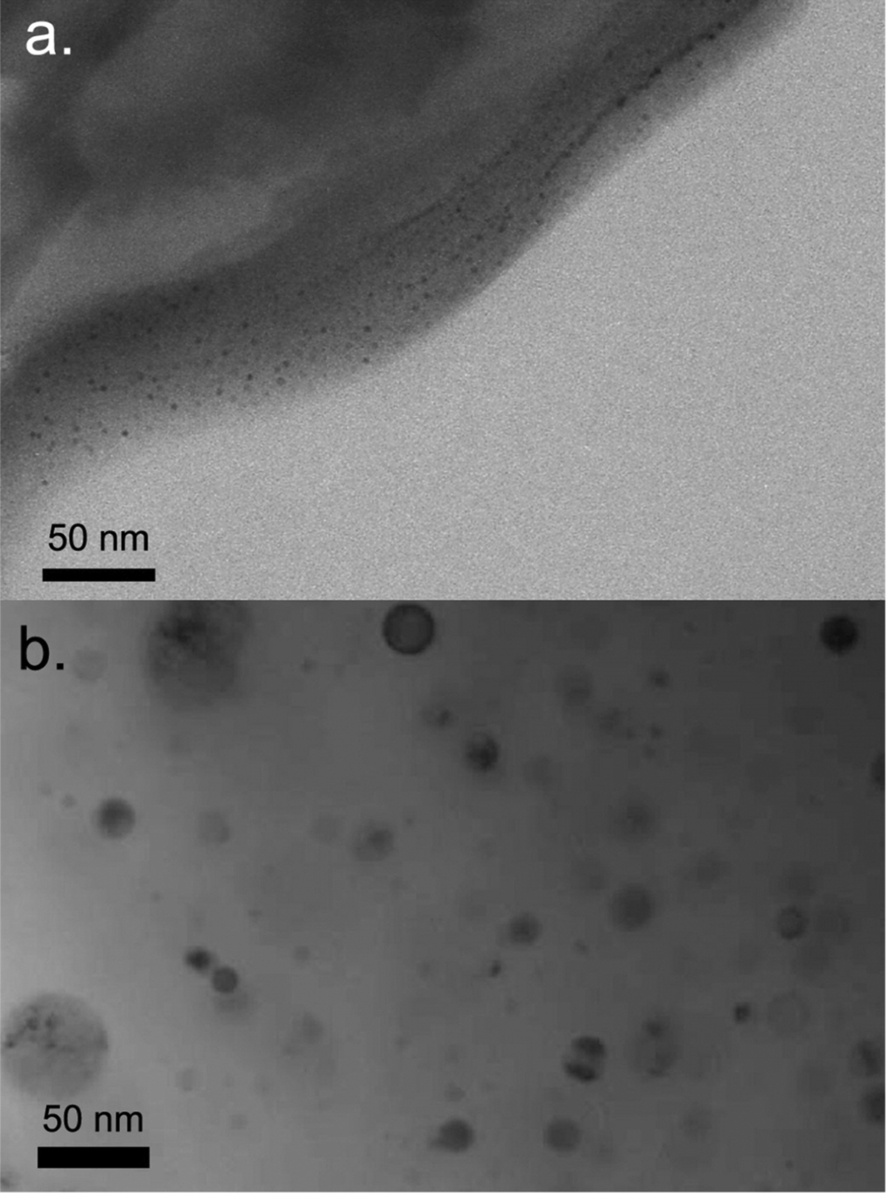
Different lunar compositions appear differently susceptible to space weathering. Mare basalts, which are iron rich, can experience much higher degrees of space weathering than highlands rocks. This is as expected, given the connection between iron and space weathering. The highlands and mare regions also appear to have different amounts of solar-wind-implanted hydrogen, a space-weathering process discussed later. In addition, minerals do not space weather in the same way, and they do not weather at the same rate.
Laboratory experiments simulating space weathering are still being undertaken today, particularly for surfaces that have only recently or are yet to be explored, like those of Mercury and low-albedo asteroids. Space weathering is best understood for the Moon, with the higher-albedo asteroid classes next-best understood.
Given the different agents creating space weathering and maturing regolith, laboratory experiments cover a variety of forms. Micrometeorite impacts are simulated by irradiating target material with laser pulses lasting a few ns, similar to the timescale over which such impacts deposit their energy. Other processes are simulated by bombarding targets with neutral atoms or ions, UV light, etc. Different experiments may be biased in varying ways (for instance, an irradiation experiment using a 1064-nm laser may affect minerals with absorptions near that wavelength more than minerals that don’t), but the suite of different techniques used for experiments in the literature helps minimize biases and understand them where they occur.
While the timescales over which these experiments can be conducted are short compared to geological timescales, the broad outline and many details concerning space weathering seem to be in place, at least where it concerns silicate-dominated objects. Fig. 6.5 shows the work of Strazzulla et al., whose results are typical of recent investigations: ordinary chondrite spectra before and after irradiation span the range of spectra seen in S-complex asteroids.
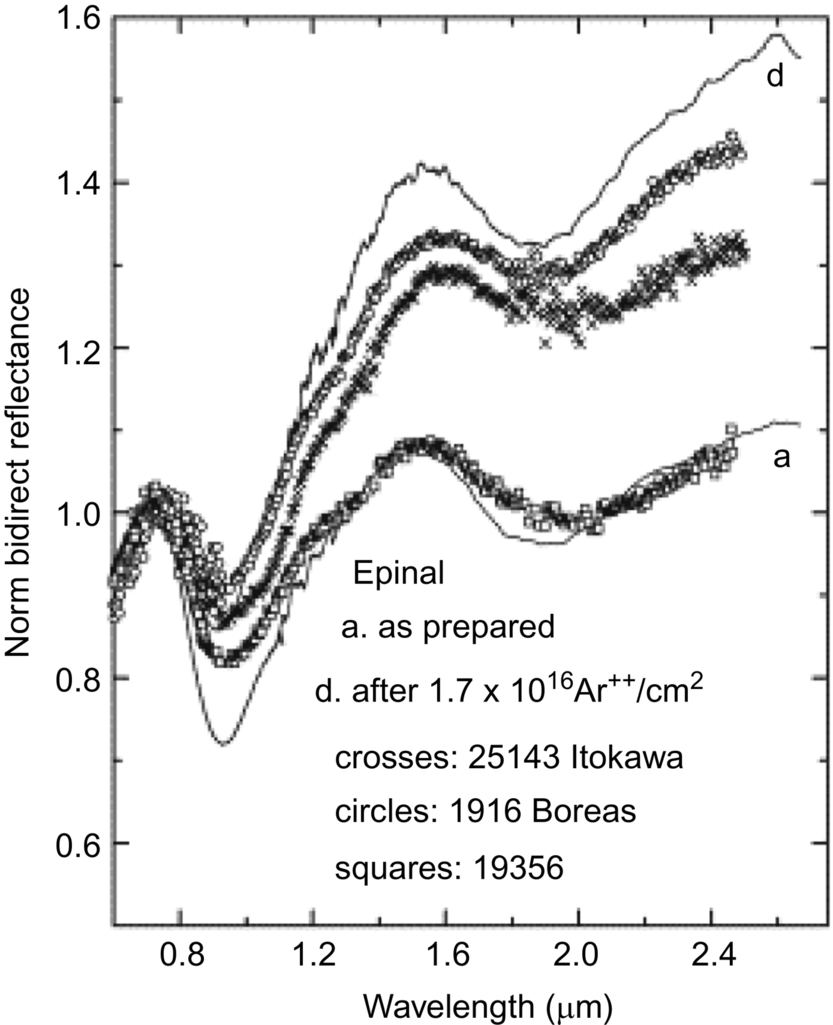
Inclusions in Grains and Space Weathering
The physical effects of soil maturation are discussed in Chapter 4, and include a redistribution of iron within mineral grains during sputtering and micrometeorite impacts leading to creation of tiny particles of iron, as detailed in papers by Noble et al. and Hapke in the Reading List. It is generally agreed that the interaction of light with these tiny particles causes the spectral changes in lunar materials associated with space weathering.
The smallest particles, termed “nanophase” or (npFe0), are < 15 nm and found on and in the rims of regolith grains. Larger particles (up to microns in size) are called “microphase” (μpFe0) and are found dispersed throughout grains or within agglutinates. Lucey and Riner showed that nanophase and microphase particles have different optical effects: the smaller particles both decrease albedo and cause reddened spectral slopes, while the larger particles serve only to darken surfaces.
We can conceptually imagine how space weathering proceeds to change the spectrum of a material. If we consider a transparent, featureless mineral grain, it will have a flat, high-reflectance spectrum when fresh. Adding μpFe0 darkens the grain across the entire 0.4–2.5 μm spectral range until at ~ 1–2 wt.% the grain is effectively saturated in terms of optical effects and the addition of more μpFe0 will not change the spectrum further. If npFe0 is added instead, it will initially affect the shorter wavelengths more strongly than the longer ones. By the time 0.1 wt.% npFe0 is added, the reflectance will be reduced by a factor of 4 or greater at 0.4 μm while the darkening at 1.8 μm is only ~ 10%–15%, resulting in a very steep spectral slope.
With further addition of npFe0, most of the effect on shorter wavelengths has occurred and the longer wavelengths begin to be affected more strongly, reducing the spectral slope. As with μpFe0, particles with ~ 2 wt.% of npFe0 are saturated and are not further affected. Spectra of particles with ~ 2 wt.% of μpFe0 and with ~ 2 wt.% of npFe0 appear similar to one another. In reality, the mineral grains we find on airless body surfaces are not featureless and transparent, but the visible-near IR band depths for absorption bands that are present in silicates are typically 10%–20% or less. Furthermore, we can recognize that as the space-weathered spectra take on more of the character of the nano- and microphase iron, the absorptions become shallower, as expected.
This conceptual model can also guide our thinking about how we would expect space weathering to work for some specific situations and objects. The nanophase and microphase iron is generated from within the mineral grains experiencing the space weathering, whether from existing iron metal or iron sulfides. If low-iron silicates dominate a surface, the spectral changes may stall very early in the progression because large (or even moderate) amounts of μpFe0 and npFe0 cannot be generated within the minerals. This explains the lack of space weathering on Vesta: the minerals on Vesta have little to no iron metal or sulfides and the weaker solar wind and slower micrometeorite speeds cannot reduce oxidized iron.
The OC meteorite parent bodies have plenty of iron metal, supporting the creation of μpFe0 and npFe0 and transformation of Q-class spectra into S-class spectra and the color changes seen on Ida. The effects seen on Eros, which seem to be albedo changes alone, could be explained by a dominance of agglutinate formation (which contain μpFe0) vs. formation of npFe0 on mineral rims.
Space Weathering on Low-Albedo Surfaces
We can also imagine applying this model to low-albedo surfaces like the C-complex asteroids or the moons of Mars. However, in this case, it is not obvious what the results would be. The starting reflectances for immature material in this case are comparable to the final reflectances for mature, iron-rich material discussed earlier. The red slopes created by npFe0 in the thought experiment are a result of differential darkening across the wavelengths under consideration, which would not be expected given the already-dark surfaces. There are few or no deep absorption bands in the 0.4–2.5 μm region to be erased by space weathering on C-complex asteroids. It is possibly no surprise that there is no consensus about the effects of space weathering on low-albedo objects. However, the ongoing Hayabusa 2 and OSIRIS-REx missions will provide useful data for investigating the spectral properties of fresh and mature material on low-albedo asteroid surfaces.
Nevertheless, at least some planetary scientists are considering space weathering of volatile-rich, low-albedo objects in the context of a wider theory of space weathering. Britt et al. propose looking at airless body surfaces as chemical systems far out of equilibrium with their environment, and that space-weathering processes can be seen as reactions that use available energy to incrementally move the surface composition toward equilibrium. On objects where hydrogen and carbon are available, they propose space weathering can undergo Fischer Tropsch–type reactions using npFe0 as a catalyst, with synthesis of long-chain carbon compounds, amino acids, and kerogen-like insoluble organic matter as a product. All of these have been found in CC material, and this hypothesis would suggest that the surface of Ceres may also be the site of organic material creation today. Kaluna et al. found some organic synthesis during pulsed laser simulations of space weathering on clay minerals, which they considered possible evidence of this process.
Space Weathering at Other Wavelengths
The bulk of spectral measurements of airless body surfaces cover the visible and near-IR wavelengths, and accordingly the bulk of space-weathering studies concentrate on those wavelengths. However, space-weathering effects can also be seen in other wavelengths, notably in the ultraviolet. The UV effects can be explained using the same conceptual model as the one used for the vis–NIR effects: As more npFe0 is added, the spectrum more closely approaches that of iron metal. Silicates have UV absorptions due to oxidized iron, so the addition of npFe0 is effectively reducing that band depth. Rather than increasing the spectral slope, as occurs at the longer wavelengths, this causes a reduction of spectral slope shortward of ~ 0.4 μm (as an analogy to reddening this is often called “bluing” or “bluening”).
Space-weathering effects have been measured in the ultraviolet spectra of lunar samples by Hendrix and Vilas and in the laboratory by Kanuchova et al., but measurements of asteroids at those wavelengths are rare. A dedicated study of the effects of space weathering on Mercury's UV spectrum has not yet been published, but the processes on that planet may result in a complicated result.
Spectral features in the midinfrared are due to the bulk crystal structure of minerals, which remains largely unaffected by space-weathering processes. Therefore, we would expect that the spectra themselves should also be unaffected. Irradiation experiments confirm this expectation when measured in ambient conditions, though there are some secondary effects: the change in reflectance in the visible wavelengths changes the thermal properties of the samples, and Shirley et al. report that mid-IR measurements of samples in lunar-like conditions show a change in Christiansen Feature position and a large loss of spectral contrast, consistent with a change in the Christiansen Feature position seen in LRO Diviner data by Lucey et al.
Sulfur and Space Weathering
Measurements of the elemental composition of Eros from the X-ray spectrometer on NEAR Shoemaker found chondritic elemental ratios except for a depletion of sulfur. The Hayabusa X-ray measurements of sulfur in Itokawa were more ambiguous, but the uncertainties were large enough to be consistent with either a depletion of sulfur or a chondritic abundance of that element. If iron sulfide is reduced to nanophase or microphase iron on asteroidal surfaces as discussed, the sulfur may be released and escape during the reduction, accounting for the sulfur depletion that is seen. However, a straightforward explanation remains elusive: laboratory measurements of grains from Itokawa show the presence of not just npFe0 but of npFeS, or nanophase iron sulfide, on the surfaces of grains. Therefore, at least some sulfur is retained through the reduction process. Furthermore, sulfur is seen on Mercury in concentrations higher than seen in chondritic meteorites, with abundances up to several percent.
It is not yet clear how to reconcile an enhancement of sulfur on Mercury with its depletion in at least one asteroid, assuming space-weathering processes are responsible for both situations, though Domingue et al. suggest a higher fraction of fine-grained material and grains more damaged by solar radiation on Mercury compared to the asteroids might provide a means for regolith to hold sulfur in situations where it would be lost on the asteroids. The much higher gravity of Mercury would also play a role in this scenario.
Shock Darkening
Many OC meteorites have been observed to have both light and dark-colored clasts, in addition to areas that are impact melted. These different fractions all share a recognizably OC composition, but have spectral differences that can be drastic. Fig. 6.6 shows spectra of the light and dark portions of the Chelyabinsk LL5 chondrite obtained by Kohout et al. in 2013. The light portion shows familiar absorptions due to olivine and pyroxene and an overall similarity to the spectrum of Q-class asteroids. The dark portion of Chelyabinsk, however, shows a very different reflectance spectrum, with a red spectral slope and absorption bands subdued or absent. This is a fairly good match for the average Xk-class spectrum that is shown. Although these spectra are normalized, the albedos of the light and dark portions of Chelyabinsk differ by a factor of 2.5.
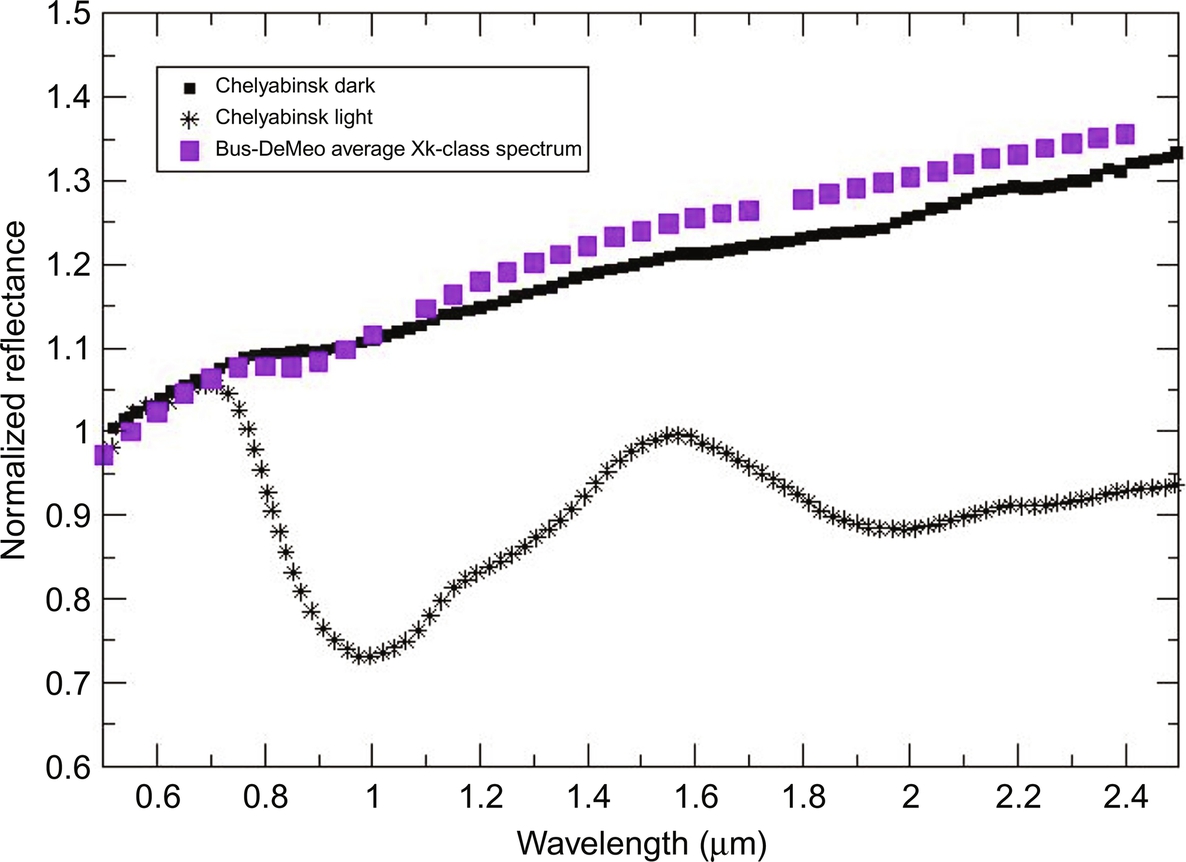
The differences we see are consistent with the effects of space weathering, and we should not be surprised to learn that they involve nanophase and microphase iron. This effect has historically been called “shock darkening” and those OC meteorites that experienced it called “black chondrites.” However, it has been noted that shock darkening can occur in meteorites that have not experienced high levels of shock. Instead, it is thought to involve frictional melting that occurs during impacts and dispersing metallic blebs through meteorite matrix as well as creating networks of tiny metallic veins.
Whether shock darkening will be an important process on large scales is an open question. OC material is currently associated with asteroids in the S spectral complex, while it is clear that shock-darkened OC asteroids would likely be classified in the C or X complexes. This may lead to a large underestimate of the amount of OC material in the NEA region and asteroid belt. However, it has also been argued that black chondrites are relatively rare and that spacecraft visits to Eros and Itokawa have revealed no areas consistent with large patches of shock-darkened material. It is not obvious how an entire asteroid covered in shock-darkened material could be created. On the other hand, Eros and Itokawa were targeted in part because they had fairly typical S-class spectra, so the lack of shock-darkened material may not be an unbiased observation. In any case, shock darkening is a process that has clearly occurred on meteorite parent bodies, and could be expected to be present on at least some NEAs of OC composition.
Solar Wind Implantation and Plasma Interactions
The hydrogen in the solar wind, in addition to other effects, can react with silicates in regolith and create hydroxyl (OH). While this is not typically considered a “space-weathering process” per se, we include it here because of its similarity: it is an external influence creating a chemical change on an airless body surface. The evolution of volatile materials on airless body surfaces is addressed in more detail in Chapter 10.
The story of volatiles on the lunar surface is thought to be closely tied to the production of hydroxyl via hydrogen implantation. While its presence was predicted prior to the Apollo landings, the difficulty of measuring trace amounts of water in returned samples and of convincingly detecting it telescopically meant that it was difficult to demonstrate that the lunar regolith was not completely anhydrous, given measurement uncertainties. It was a combination of three spacecraft (Deep Impact, Cassini, and Chandrayaan-1) releasing a coordinated but independent set of studies that established hydroxyl existed on the lunar surface outside of the permanently shadowed areas discussed in other chapters. All three spacecraft found spectroscopic evidence of OH near 2.8 μm, with Deep Impact data showing further evidence of an orbital cycle: measurements are consistent with more OH nearer sunrise and sunset than near noon—this was interpreted as meaning that the temperatures near lunar noon are too high to retain OH, but it begins to reaccumulate as late afternoon temperatures begin to drop. Overnight there is no direct line to the sun; therefore, solar wind protons cannot create hydroxyl. There is also evidence from laboratory simulations and measurements of lunar samples that highland materials can hold more OH than mare materials.
Solar-wind creation of hydroxyl is a surface process, affecting particles within a millimeter or less of the surface. Given the expected rate of regolith gardening, particles at the lunar surface might reach their capacity for retaining hydrogen. However, Farrell et al. showed that the fraction of incoming solar wind protons that are retained by regolith grains is apparently small, so the equilibrium amount of hydrogen in the lunar regolith is much less than the theoretical maximum.
There has been ongoing debate as to whether this process can go beyond OH formation and create water per se. It is easy to envision simply adding another solar wind proton to existing OH to do so, given the proper conditions. Such water could then be transported across the surface until escaping or reaching a cold trap, serving as an additional source for polar ice. However, it is not clear if the conditions on the lunar surface are compatible with H2O formation, or if the thermodynamics prevent the creation of water per se in the regolith.
As with other forms of space weathering, solar wind implantation and creation of hydroxyl should in principle be occurring on other airless bodies as well as the Moon. However, evidence is still somewhat circumstantial. MESSENGER was not equipped with an instrument capable of measuring spectra in the 3-μm region, and Earth-based observations would be especially tricky since they would need sufficient spatial resolution to distinguish those parts of Mercury that are cool enough to retain OH. NEAR Shoemaker also did not carry a spectrometer to Eros that could measure the OH band at 2.8 μm, though a recent re-evaluation of gamma-ray spectrometer data by Peplowski et al. concluded that 400–2700 ppm of hydrogen was present at its landing site in a pond near Himeros crater.
Ground-based observations by Rivkin et al. of Eros and another S-class NEO, (1036) Ganymed, indicate a shallow absorption band in the 3-μm region consistent with a few hundred ppm of hydrogen in OH, though the band center is obscured by water in the Earth's atmosphere (see Chapter 10 for a fuller discussion of the challenges of detecting water from the Earth's surface). A re-evaluation by Granahan of measurements of Gaspra by the Galileo spacecraft shows a 2.8-μm band similar to what is seen on the Moon. However, Eros (and perhaps the other objects) has meteorite analogs that have been known, rarely, to have native hydrated minerals. Therefore, it is not completely clear whether the hydroxyl seen is due to an external process. Similarly, the detection of hydrogen/hydroxyl on Ceres by Dawn's GRaND instrument and VIR spectrometer and by ground-based observations is interpreted as native hydrated materials, and analogous observations on Vesta are interpreted as due to infalling carbonaceous material rather than solar-wind implanted hydrogen (see Chapter 11). The interpretation for Vesta in particular is influenced by the saturation levels thought to be on the Moon versus higher levels of hydrogen seen on Vesta.
Dating Surfaces With Space Weathering
In principle, determining the rate of space weathering on airless bodies could lead directly to its use as a dating technique, at least up to the age at which surfaces reach maximum maturity (akin to crater saturation, discussed in Chapter 4). This approach has been used on studies of the Moon and asteroid populations, though there are nuances to be aware of in each case.
The concept of using space weathering to determine the relative ages of surfaces is straightforward. Measurements of Ida during the flyby of Galileo showed that some areas had steeper spectral slopes in visible wavelengths, and that those areas with shallower slopes also tended to be associated with fresher-looking craters. Assuming Ida is compositionally homogeneous across its surface, this is consistent with the signs of space weathering and it is reasonable to assume that visible spectral slope is a measure of age on Ida's surface. Similarly, within an asteroid family where members can be expected to have the same composition, differing spectral slopes between family members can be seen as evidence for space weathering and a proxy for age. When we look at the Moon, different optical maturity (OMAT) values should represent different degrees of maturation and thus different ages, as discussed in detail in Chapters 4 and 5.
Attempts have also been made to tie space weathering to quantitative ages. Laboratory studies of space weathering have shown that expected rates are very rapid, with detectable spectral effects on the timescale of millions of years and perhaps as short as tens of thousands of years. These experiments, as mentioned earlier, are done in vacuum with either ion beams or lasers irradiating the samples. Because the timescales for the laboratory experiments are by necessity much shorter than geologic timescales, the amount of spectral and textural change is usually interpreted with regard to the total fluence of ions (ions per surface area) or the total amount of energy deposited, which is then converted into a timescale by using known or estimated solar wind or micrometeorite impact rates. It is not thought that this mismatch between laboratory and natural timescales and energy deposition rates has an effect on the results, but if such a mismatch were important it would obviously require revision of conventional wisdom.
It can also be noted that laboratory studies are typically not performed at asteroidal temperatures. This should not affect results with respect to NEAs, which have average temperatures not far from typical laboratory temperatures, but it may be relevant to studies of main-belt asteroids. Compounding this, it has been shown by several workers (and re-emphasized by Hinrichs and Lucey in 2002) that the reflectance spectra of silicate minerals can change with temperature alone, and care must be taken to separate spectral differences between objects that are irreversible and due to a physical change from those reversible changes due to temperature.
An alternate approach is strictly data-based. As noted above and below, an attempt to quantify the effects of space weathering and regolith maturity on spectra is the OMAT parameter, discussed in detail in Chapters 4 and 5. This was defined for use with Clementine images of the Moon but can be redefined depending upon available data. The OMAT parameter can be used in conjunction with the radiometrically determined ages of certain lunar craters to estimate ages of other areas, discussed in Chapter 5.
In the simplest sense the fact that Copernicus crater, which is 800 My old, is nearly matured to the background level, can be used to interpret craters with OMAT values different from the background. Estimates based on Copernicus suggest that the OMAT value reaches maturity saturation between 800 and 1000 My (Grier et al., 2000). Therefore, those craters that appear less mature than the background should be less than ~ 800–1000 My old and conversely those that are indistinguishable from the background are older than ~ 800–1000 My. However, additional work is necessary to determine how OMAT changes depending on crater size, as well as whether it changes linearly with age.
No asteroid samples have been radiometrically dated and tied to a specific location. However, the formation ages for several asteroid families have been calculated (see Chapter 9) and can be used instead of radiometric ages. The average spectral slope for a family is used as the indicator of space-weathering progress, with an implicit assumption that any compositional or innate spectral slope differences between families are small enough that they will not affect the results. The recent progress that has been made in identifying smaller and younger families and with using the orbit changes caused by the Yarkovsky force to date those families, combined with the common nature of S-class asteroids, has led to the opportunity for several studies to be carried out (Fig. 6.7).
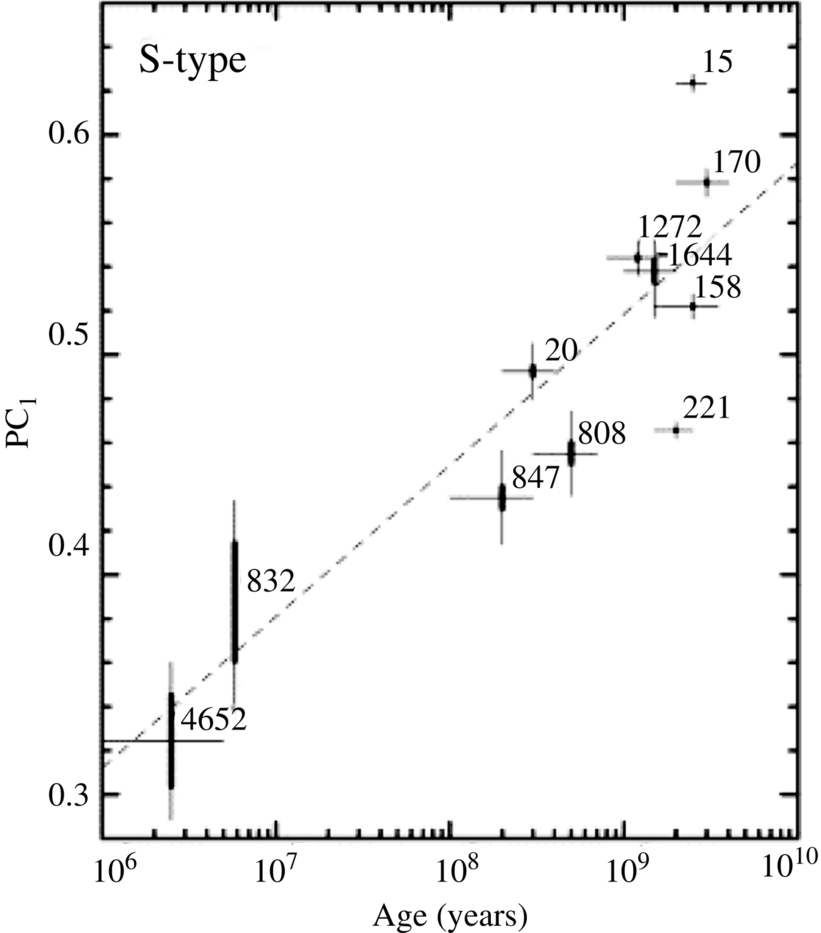
These studies suggest that space weathering has two timescales for asteroids: a rapid weathering that occurs over ~ My timescales and a slower process that continues over ~ Gy timescales. This second timescale is consistent with the lunar OMAT timescale suggested by the Copernicus work. Reviews of the literature suggest that an object with OC composition in the main asteroid belt will be space weathered ~ 50% to completion in ~ 1–10 My, possibly via solar wind bombardment, with the slower rate representing more gradual regolith processes or perhaps the longer times required for larger particles and blocks to be affected by space weathering. Interestingly, applications of this technique to C-complex families have yet to reach a consensus on whether spectral slopes increase or decrease with time, mirroring the uncertain consensus from laboratory studies.
The S-complex NEA population has also been used to study space weathering. These studies have focused on looking at trends in spectral slope vs object size. First, because size is related to surface gravity, which was expected to influence the amount of regolith present on an asteroid, and also because size was thought to serve as a proxy for age because smaller objects have shorter collisional lifetimes and so on average should have younger surfaces.
In the early 2000s Binzel et al. found a correlation between size and spectral slope such that on average, spectral slopes for S-complex NEAs changed from OC-like to main-belt-like as their sizes increased from 2 to 5 km. At the time, this was interpreted as meaning that 5-km objects last long enough to become fully weathered while 2-km objects did not survive long enough to experience weathering. Since that time, however, advances in understanding a variety of resurfacing processes and a reassessment of the collisional lifetimes of NEAs leave the interpretation of the cause of the observed trend less clear.
“Resetting” Space Weathering Effects
Near-Earth Asteroids have typical dynamical lifetimes of a few tens of My before they impact a planet or the Sun. The Moon has been in our skies for billions of years, and large main-belt asteroids have been in their orbits for similar lengths of time. Even smaller main-belt asteroids, which are thought to be effectively large pieces of ejecta from catastrophic impacts (see Chapters 7 and 11), have had their surfaces exposed to space for tens or hundreds of My or longer. We have just seen that the timescales for space weathering are very short—<10 My and by some estimates effects can be seen in < 100,000 years.
With airless surfaces exposed to the processes involved in space weathering, and with those processes reaching completion or saturation very quickly compared to the age of the solar system, we may wonder why any surfaces appear fresh at all. Two related effects lead to fresh material appearing on these surfaces: exhumation or deposit of material via impact or mass wasting and disintegration of blocks leading to creation of new regolith. On all of the objects we consider here, impacts can pierce a space-weathered surface layer and bring fresh material upward. The Hayabusa 2 spacecraft is using an impactor to expose fresh material to be collected and brought to Earth, along with material that was exposed to micrometeorites, the solar wind, etc.
On the Moon and Mercury, gravity is sufficiently strong that most ejecta from impacts falls back, which can deposit fresh material in ejecta blankets or rays. There is a constant churn from impacts, which also mixes mature regolith with immature regolith as it brings the immature regolith upward. Sufficiently large impacts can also create new immature regolith, either by breaking up blocks into smaller, immature fragments, or via impact melting of mature regolith, destroying it and creating fresh immature regolith in the process. See Chapters 7 and 8 for more discussion of the creation and movement of regolith that contributes to changes in visible soil maturity.
Some of the larger asteroids have sufficiently strong gravity to keep some impact ejecta, and fresh material is exposed by cratering impacts as seen on Ida and discussed earlier. For the majority of asteroids, practically all impact ejecta escapes. However, seismic waves from impacts can cause mass wasting across asteroid surfaces, again exposing fresh material. Images of Eros show clear evidence of space-weathered material slumping to the bottom of craters, with fresher material exposed as a result (Fig. 6.8). Models suggest that the impact of a 20-cm object into a 5-km object is powerful enough to cause “vertical launching” of regolith (Richardson et al. 2005), and rough calculations lead to an estimate that 5-km diameter objects in the main asteroid belt might be reset, at least in part, by impacts on My timescales.
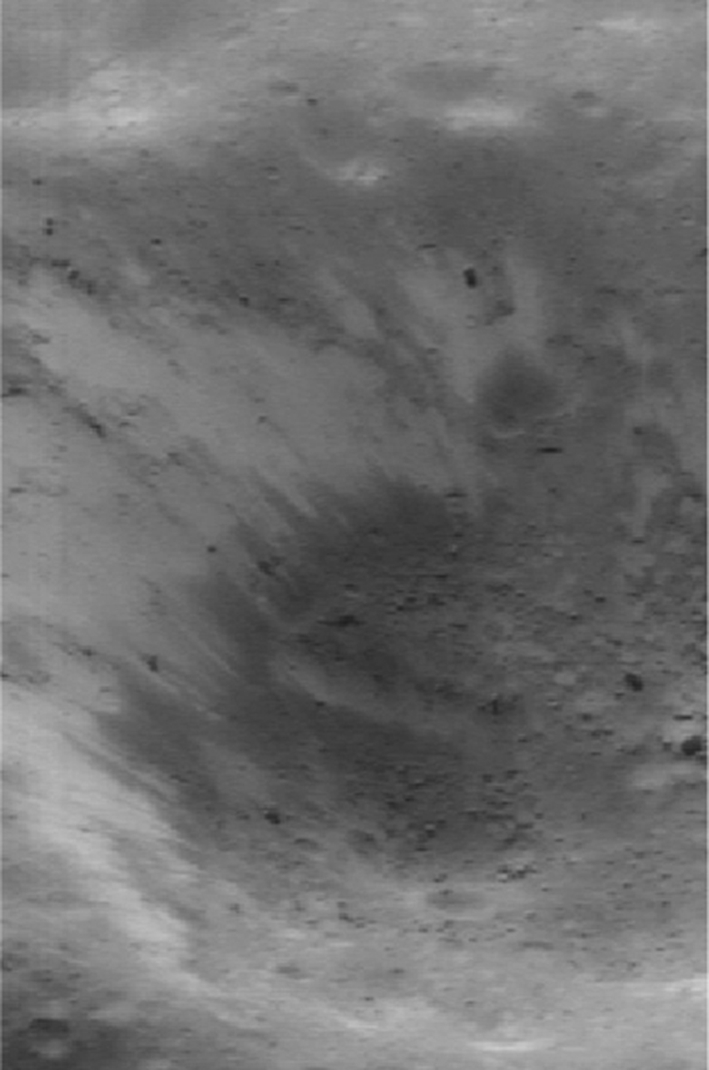
Because impacts on near-Earth asteroids seemed to occur too infrequently to be a major factor in resetting their surfaces, it was suggested that close passes to planets could be an important process. Nesvorny et al. considered close encounters and determined that because of the very short-range nature of tidal forces it was unlikely that encounters further away than 5 planetary radii would have any effect. Given the frequency of encounters within that distance and the relative fraction of Q-class and S-class asteroids, that suggests that the space-weathering timescale is ~ 1 My. However, their calculations were unable to provide suitable matches to large-perihelion and small-perihelion populations using the same parameters for both populations. This led them to suspect another process could be at work, and they suggested that the YORP torque, discussed in Chapter 9, was a good candidate to be that process.
The primary process for resetting space weathering on asteroid surfaces is indeed now thought to be the YORP torque, a thermal force primarily affecting ~ 100 m–10 km objects. YORP can increase the spin rate of objects without bound, up to the point where they lose mass and (as a result) angular momentum. At intermediate stages, it is thought to move material from polar areas to lower-latitude ones. Graves et al. used colors for over 6000 S-complex asteroids and a mathematical simulation of YORP spinup to resurfacing events on a model population, finding that the timescale (τ) for Q-class spectra to be weathered into S-class spectra is
where τ0 is estimated as 1.7–7.2 My, a0 is 1 AU, a is the orbit semimajor axis in AU, and e is the orbit eccentricity (see discussion of those terms in Chapter 9 if needed). At 1 AU, then, the timescale is ~ 2–7 My, while an orbit in the Flora asteroid family (a ~ 2.25 AU, e ~ 0.14) would give a timescale of ~ 8–36 My. The e-folding time for space-weathering completion uses the same form, but τ0 is 4.0–16.5. The values for τ0 are not precise to 0.1 My, as can be seen by their spread, but are included here to that precision to allow recalculation of literature values.
Summary
Silicate mineral grains at the surfaces of airless bodies experience micrometeorite impacts, interactions with cosmic rays, solar wind bombardment, and other processes that create pockets of reduced iron. These pockets, with size scales of < 1 μm, change the spectra of their host grains to have increased spectral slopes, muted spectral contrast, and lower albedos, with these changes occurring to differing relative degrees depending upon the amount and size of the reduced iron. The processes that cause the spectral changes are collectively called space weathering. While the overall process of space weathering is fairly well understood on the Moon and S-complex asteroids, there is a great deal of work left to be done for understanding how it proceeds on Mercury and low-albedo objects. The apparently rapid timescale on which space weathering progresses combined with the existence of fresh, unweathered surfaces demonstrates that fresh material is brought to the surface of airless bodies. The mechanisms for doing so vary from object to object, with impact exhumation of fresh regolith and the creation of new regolith likely the most important process on the Moon and Mercury, while YORP-driven spin up and creation of new regolith via thermal fracturing (see Chapter 7) likely the most important processes on small asteroids.
